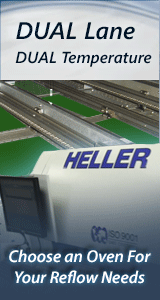Printed Circuit Board Assembly & PCB Design Forum
SMT electronics assembly manufacturing forum.
- SMTnet
- »
- Electronics Forum
- »
- Problems with SN100C in a Soltec Delta C Wave
Problems with SN100C in a Soltec Delta C Wave
Views: 8847
![]() Hi,
We have spent the day trying to profile our Vitroncis...
- Jun 09, 2006
by
Grant
Hi,
We have spent the day trying to profile our Vitroncis...
- Jun 09, 2006
by
Grant
![]()
![]()
![]() I think You should try to do the Delta X test, because there...
- Jun 09, 2006
by
I think You should try to do the Delta X test, because there...
- Jun 09, 2006
by
![]()
![]() I am sorry, but I hope No hard feelings? :)
As for an answe...
- Jun 09, 2006
by
I am sorry, but I hope No hard feelings? :)
As for an answe...
- Jun 09, 2006
by
![]()
![]() Hi,
Very funny, and I feel so much better not because of ...
- Jun 09, 2006
by
Grant
Hi,
Very funny, and I feel so much better not because of ...
- Jun 09, 2006
by
Grant
![]()
![]()
![]() Dont't bother to answer real idiots!
I can relate to a si...
- Jun 10, 2006
by
Mika
Dont't bother to answer real idiots!
I can relate to a si...
- Jun 10, 2006
by
Mika
![]()
![]()
![]() Yeehaa! there little doggies, y'all just got to mine that th...
- Jun 10, 2006
by
Yeehaa! there little doggies, y'all just got to mine that th...
- Jun 10, 2006
by
![]()
![]() Grant,
I beleive your problem may lie in the top side hea...
- Jun 11, 2006
by
Grant,
I beleive your problem may lie in the top side hea...
- Jun 11, 2006
by
![]()
![]() Flux: Getting enough- is the spray fluxer getting good throu...
- Jun 12, 2006
by
Flux: Getting enough- is the spray fluxer getting good throu...
- Jun 12, 2006
by
![]()
![]() Hi Grant,
Boy, how do I say this - I might have to agree ...
- Jun 12, 2006
by
Hi Grant,
Boy, how do I say this - I might have to agree ...
- Jun 12, 2006
by
![]()
![]() Hi Grant,
You definitely have a pre-heat problem and not ...
- Jun 12, 2006
by
Patrick Bruneel
Hi Grant,
You definitely have a pre-heat problem and not ...
- Jun 12, 2006
by
Patrick Bruneel
![]()
![]()
![]() My brother-in-law is a DDS and I trust him. We had some pro...
- Jun 12, 2006
by
My brother-in-law is a DDS and I trust him. We had some pro...
- Jun 12, 2006
by
![]()
![]() It's hard to believe MoonMan spends this much time typing th...
- Jun 12, 2006
by
It's hard to believe MoonMan spends this much time typing th...
- Jun 12, 2006
by
![]()
![]() Hi,
Thanks guys for all the suggestions. I am going to ch...
- Jun 12, 2006
by
Grant
Hi,
Thanks guys for all the suggestions. I am going to ch...
- Jun 12, 2006
by
Grant
![]()
![]()
![]() Hi.
I agree that the Soltec has weak, low-wattage prehe...
- Jun 12, 2006
by
Hi.
I agree that the Soltec has weak, low-wattage prehe...
- Jun 12, 2006
by
![]()
![]() Hi,
Thanks, and we are doing that today. After spending t...
- Jun 12, 2006
by
Grant
Hi,
Thanks, and we are doing that today. After spending t...
- Jun 12, 2006
by
Grant
![]()
![]()
![]() Hi,
ok, I have a bit more info after playing further with...
- Jun 13, 2006
by
Hi,
ok, I have a bit more info after playing further with...
- Jun 13, 2006
by
![]()
![]() Well grant just to let you know i feel your pain. I've been ...
- Jun 13, 2006
by
bruce
Well grant just to let you know i feel your pain. I've been ...
- Jun 13, 2006
by
bruce
![]()
![]()
![]() Your new problem is inadequate flux coverage.
This may ...
- Jun 13, 2006
by
RDR
Your new problem is inadequate flux coverage.
This may ...
- Jun 13, 2006
by
RDR
![]()
![]()
![]() Hi,
Your right guys, and we turned off the chip wave, and...
- Jun 13, 2006
by
Grant
Hi,
Your right guys, and we turned off the chip wave, and...
- Jun 13, 2006
by
Grant
![]()
![]()
![]() Hi,
Is it possible to have too much flux?
Grant
...
- Jun 13, 2006
by
Grant
Hi,
Is it possible to have too much flux?
Grant
...
- Jun 13, 2006
by
Grant
![]()
![]()
![]() Samir's ICT guy says YES.
...
- Jun 13, 2006
by
Samir's ICT guy says YES.
...
- Jun 13, 2006
by
![]()
![]() Yes it's definately possible to have too much flux. You'll s...
- Jun 14, 2006
by
bruce
Yes it's definately possible to have too much flux. You'll s...
- Jun 14, 2006
by
bruce
![]()
![]()
![]() What rpm is the Delta wave going at? (I think it was recomme...
- Jun 14, 2006
by
Rob
What rpm is the Delta wave going at? (I think it was recomme...
- Jun 14, 2006
by
Rob
![]()
![]()
![]() Hi,
Thanks for all the help guys, and we did a bunch of t...
- Jun 14, 2006
by
Grant
Hi,
Thanks for all the help guys, and we did a bunch of t...
- Jun 14, 2006
by
Grant
![]()
- SMTnet
- »
- Electronics Forum
- »
- Problems with SN100C in a Soltec Delta C Wave







